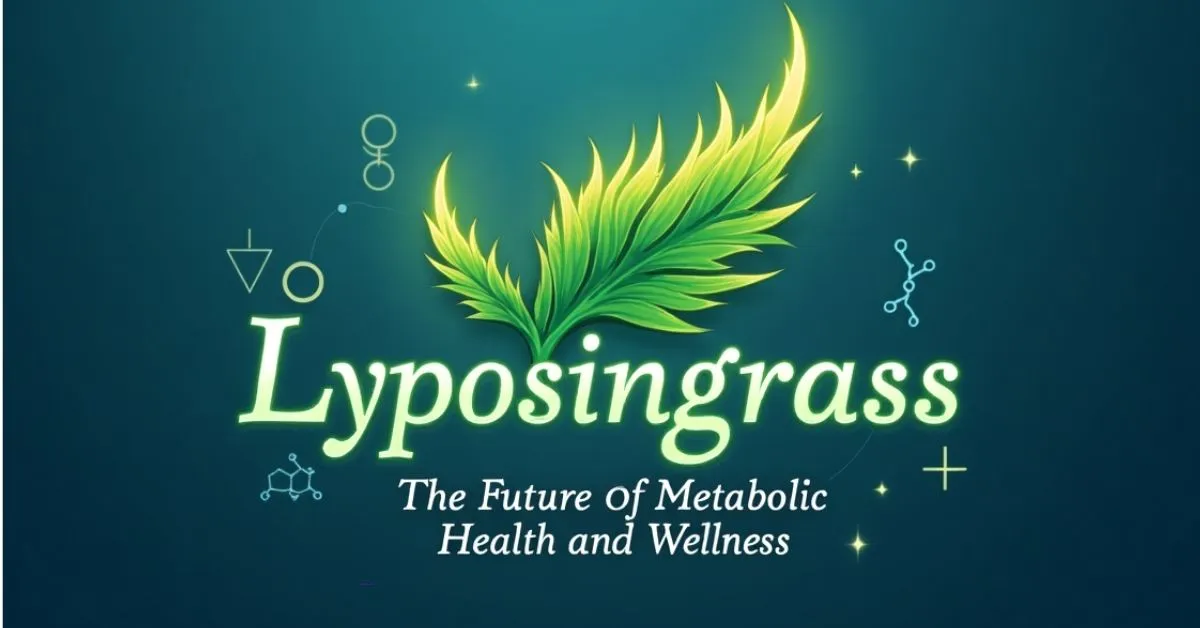Lyposingrass: The Future of Metabolic Health and Wellness
In recent years, the world of botanical wellness has witnessed the rise of a new contender—lyposingrass. While still in the early stages of scientific exploration, It has already gained attention for its potential benefits in metabolic health, weight management, and overall wellness. With roots in the marshlands of Southeast Asia, this unique grass-like plant is not only catching the eyes of alternative medicine enthusiasts but is also making its way into academic research as a potential breakthrough in fat oxidation and metabolic efficiency.
This article delves into what lyposingrass is, its origins, its chemical composition, mechanisms of action in the human body, and potential applications in wellness and medicine. Furthermore, we will explore how it compares to traditional herbal extracts, current research findings, safety, and regulatory status, and its future in the market.
What is Lyposingrass?
It is a botanical compound derived from a species of grass native to Southeast Asia, specifically Thailand and parts of Laos. Unlike lemongrass, which is known for its culinary uses, lyposingrass is primarily valued for its metabolic benefits, particularly its ability to support lipid metabolism. The plant contains lipid-targeting phytochemicals, such as lypolines—non-stimulant molecules thought to influence the mitochondria in fat cells, thereby promoting fat oxidation and improving metabolic efficiency.
Despite its increasing recognition in the wellness world, lyposingrass remains largely unexplored by the general public. It is not yet an approved pharmaceutical or a regulated supplement in many countries. However, its potential benefits, particularly in managing fat oxidation, appetite, and metabolic health, are promising. Researchers are actively investigating whether lyposingrass could become a new tool in the fight against metabolic disorders, such as obesity and insulin resistance.
Botanical Origins and Historical Context
It is a relative newcomer to the scientific community, yet it has a long history of use in local medicinal practices. Native to the wetlands of Southeast Asia, It has been used for centuries by local herbalists in northern Thailand and Laos. Traditionally, it was applied externally in poultices to reduce swelling and treat skin inflammation. Its internal metabolic benefits, however, were not recognized until much more recently.
The plant’s potential for metabolic support was first documented by a team of ethnobotanists from Chiang Mai University in 2012. During their research on the region’s underdocumented flora, they identified and extracted lyposingrass for laboratory analysis. Interestingly, farmers and agriculturalists had observed that water buffaloes grazing on this grass appeared leaner and more agile, prompting further scientific investigation into its biochemical makeup.
In 2016, controlled studies at Chiang Mai University confirmed that lyposingrass may indeed have metabolic benefits, setting the stage for broader exploration into its potential applications in human health.
Chemical Composition and Biological Activity
One of the key factors that makes lyposingrass unique is its chemical composition. Preliminary phytochemical analyses reveal that the plant contains several potent bioactive compounds, including:
- Lypolines: These are non-stimulant molecules believed to influence mitochondrial function in white adipose tissue. Lypolines are thought to help with fat oxidation without stimulating the central nervous system, making them a safer alternative to compounds like caffeine and synephrine, which are commonly used in weight loss supplements.
- Catechin-like Flavonoids: These flavonoids, structurally similar to those found in green tea, are known for their antioxidant properties. They may help improve blood circulation, reduce inflammation, and support overall metabolic health.
- Plant Sterols: These compounds have been shown to reduce cholesterol absorption in the body, potentially improving cardiovascular health.
- Saponins: Known for their emulsifying properties, saponins may also have immune-boosting effects, helping to strengthen the body’s natural defenses.
- Volatile Terpenes: Although non-aromatic, these compounds are believed to have mood-regulating effects, which could potentially offer subtle mental and emotional benefits.
The synergy of these compounds is theorized to promote gentle lipolysis (the breakdown of fat cells) without causing the overstimulation often associated with thermogenic supplements. This makes lyposingrass an attractive option for those seeking non-stimulant metabolic support.
Mechanisms of Action in the Human Body
While much of the research on lyposingrass is still in the preliminary stages, early studies have revealed several promising mechanisms by which it may impact metabolism and fat reduction:
AMPK Activation:
Lyposingrass appears to activate AMP-activated protein kinase (AMPK), which is often referred to as the “metabolic master switch.” When AMPK is activated, it promotes the breakdown of stored fat for energy. This process is particularly important for individuals trying to manage body fat and improve metabolic efficiency.
Inhibition of Fat Cell Proliferation:
Laboratory tests on adipocyte (fat cell) cultures suggest that lyposingrass may reduce mitotic activity in pre-fat cells, limiting the creation of new fat cells. This could potentially prevent fat accumulation over time and help manage body fat levels more effectively.
Improved Lipid Transport:
In animal studies, lyposingrass has been shown to enhance the movement of fatty acids into mitochondria for oxidation, particularly in the liver. This could contribute to more efficient fat burning and overall metabolic function.
Cortisol Buffering:
In vitro studies suggest that lyposingrass may have mild cortisol-buffering effects. Cortisol, a stress hormone, is often associated with fat storage, particularly in the abdominal region. By reducing the impact of cortisol on fat storage mechanisms, lyposingrass could help mitigate stress-induced weight gain.
Lyposingrass vs. Traditional Herbal Extracts
When comparing lyposingrass to more well-known herbal extracts, there are several important distinctions. Traditional herbal extracts such as green tea extract and Garcinia Cambogia are often used in weight management and metabolic health, but they rely on different mechanisms of action:
- Green Tea Extract: Primarily works through catechins that promote thermogenesis (heat production) and fat oxidation. However, green tea extract can cause gastrointestinal distress in some individuals.
- Garcinia Cambogia: Known for its ability to suppress appetite, Garcinia Cambogia works by inhibiting fat production. It is, however, associated with side effects such as headaches and fatigue.
- Lyposingrass: Unlike these herbal extracts, lyposingrass does not rely on thermogenesis or appetite suppression. Instead, it works more subtly by promoting fat oxidation at the cellular level and inhibiting the proliferation of fat cells. This makes it an excellent choice for individuals who are sensitive to stimulants or looking for a non-intrusive approach to weight management.
Research: What We Know So Far
While much of the research on lyposingrass is still in its infancy, several studies have shown promising results. For example:
- A 2018 study on rats revealed that supplementation with lyposingrass led to a 17% reduction in fat mass after 6 weeks.
- In 2020, in vitro tests found that lyposingrass extract reduced lipid droplet accumulation in fat cells by 22%.
- Human pilot studies are currently underway in Vietnam and Thailand, with preliminary results suggesting improved insulin sensitivity markers after consistent dosing.
Although these findings are encouraging, further research is needed to confirm the plant’s efficacy in humans. Large-scale, placebo-controlled clinical trials are crucial to determine whether lyposingrass can be reliably used in clinical practice.
Safety and Regulatory Status
As of 2025, lyposingrass is not yet regulated by major health authorities like the FDA or EMA. While the safety profile is promising, with no toxicity observed in high-dose animal studies, there are still a few important considerations:
- Pregnancy and Breastfeeding: Due to a lack of reproductive safety data, pregnant or breastfeeding women are advised to avoid lyposingrass.
- Drug Interactions: Although no contraindications with major medications have been reported, the potential for drug interactions has not been fully explored.
- General Safety: No significant side effects have been reported in animal studies, but more research is needed to ensure that lyposingrass is safe for long-term human use.
Potential Applications in Wellness and Medicine
Lyposingrass holds potential for a variety of applications in both preventative health and targeted interventions. Some possible uses include:
- Weight Management: As a complementary addition to lifestyle changes such as diet and exercise, lyposingrass may help individuals manage body fat more effectively.
- Pre-Diabetic Support: Preliminary studies suggest that lyposingrass may improve lipid profiles and insulin sensitivity, making it a potential aid for individuals with pre-diabetes.
- Non-Stimulant Metabolic Boost: For those who are sensitive to stimulants such as caffeine, lyposingrass could offer a gentler, stimulant-free alternative for metabolic support.
- Chronic Inflammation Reduction: Through its indirect effects on adipose tissue cytokines, lyposingrass may help reduce inflammation, which is a key contributor to a variety of chronic conditions.
Market Trends and Consumer Awareness
The demand for lyposingrass is currently niche, but growing. In 2025, online interest in the plant has risen 74% year-over-year, driven by wellness influencers, biohackers, and discussions on platforms like Reddit. In Asia, where traditional medicine systems are more open to experimenting with new botanicals, lyposingrass is beginning to make a name for itself.
Western markets are also showing growing interest in plant-derived compounds as synthetic fat burners fall out of favor. Market analysts predict that lyposingrass could become a $100M niche industry within the next five years if research continues to show positive results.
The Future of Lyposingrass
Lyposingrass stands at a crossroads. It could either fade into obscurity or become the focus of groundbreaking pharmacological developments. Several possible paths include:
- Isolated Compound Development: Pharmaceutical companies may isolate lypolines for further study as potential drug candidates for obesity treatment.
- Nutraceutical Standardization: Supplement companies may push for standardized extraction protocols to ensure consistent dosages.
- Agricultural Expansion: If the plant proves to be effective, it could see widespread cultivation for commercial use.
- Synthetic Replication: Researchers could attempt to synthesize key compounds for better scalability and availability.
Regardless of the direction it takes, the future of lyposingrass depends on rigorous scientific research and clinical trials.
Final Thoughts
Lyposingrass offers exciting potential for metabolic health and wellness. While much of the current data is preliminary, the early research is promising, and it may one day become a staple in the toolkit for managing weight, supporting metabolic health, and reducing chronic inflammation. As always, further research is needed to validate these claims, but lyposingrass could soon play a pivotal role in the natural wellness landscape.





